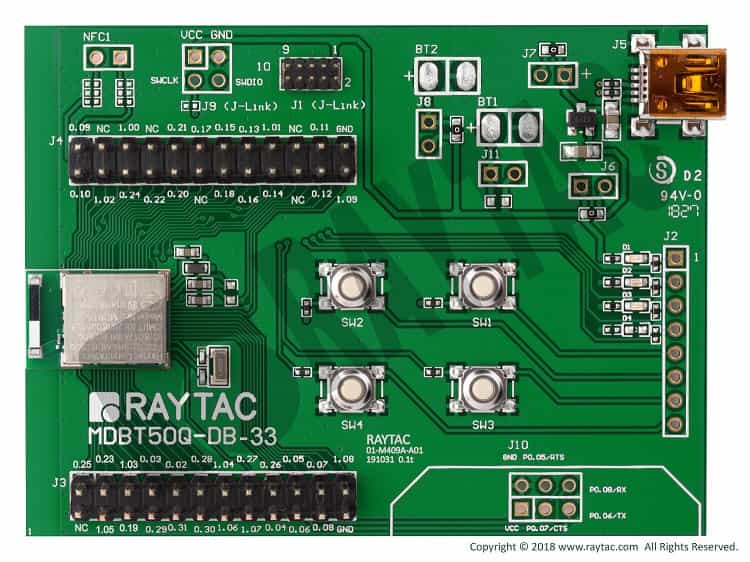Raytac MDBT50Q-DB-33
Overview
The Raytac MDBT50Q-DB-33 hardware provides support for the Nordic Semiconductor nRF52833 ARM Cortex-M4F CPU and the following devices:
ADC
CLOCK
FLASH
GPIO
I2C
MPU
NVIC
PWM
RADIO (Bluetooth Low Energy and 802.15.4)
RTC
Segger RTT (RTT Console)
SPI
UART
USB
WDT

More information about the board can be found at the MDBT50Q-DB-33 website [1]. The MDBT50Q-DB-33 Specification [2] contains the demo board’s datasheet. The MDBT50Q-DB-33 Schematic [3] contains the demo board’s schematic.
Hardware
Module Demo Board build by MDBT50Q-512K
Nordic nRF52833 SoC Solution
A recommnded 3rd-party module by Nordic Semiconductor.
BT5.2&BT5.1&BT5 Bluetooth Specification Cerified
Supports BT5 Long Range Features
Cerifications: FCC, IC, CE, Telec(MIC), KC, SRRC, NCC, RCM, WPC
32-bit ARM® Cortex™ M4F CPU
512kB Flash Memory/128kB RAM
RoHs & Reach Compiant.
42 GPIO
Chip Antenna
Interfaces: SPI, UART, I2C, I2S, PWM, ADC, NFC, and USB
Highly flexible multiprotocol SoC ideally suited for Bluetooth® Low Energy, ANT+, Zigbee, Thread (802.15.4) ultra low-power wireless applications.
3 User LEDs
4 User buttons
1 Mini USB connector for power supply and USB communication
SWD connector for FW programing
J-Link interface for FW programing
UART interface for UART communication
Supported Features
The raytac_mdbt50q_db_33/nrf52833 board configuration supports the following hardware features:
Interface |
Controller |
Driver/Component |
|---|---|---|
ADC |
on-chip |
adc |
CLOCK |
on-chip |
clock_control |
FLASH |
on-chip |
flash |
GPIO |
on-chip |
gpio |
I2C(M) |
on-chip |
i2c |
MPU |
on-chip |
arch/arm |
NVIC |
on-chip |
arch/arm |
PWM |
on-chip |
pwm |
RADIO |
on-chip |
Bluetooth, ieee802154 |
RTC |
on-chip |
system clock |
RTT |
Segger |
console |
SPI(M/S) |
on-chip |
spi |
UART |
on-chip |
serial |
USB |
on-chip |
usb |
WDT |
on-chip |
watchdog |
Other hardware features have not been enabled yet for this board. See MDBT50Q-DB-33 website [1] and MDBT50Q-DB-33 Specification [2] for a complete list of Raytac MDBT50Q-DB-33 board hardware features.
Connections and IOs
LED
LED1 (green) = P0.13
LED2 (red) = P0.14
LED3 (blue) = P0.15
UART
RXD = P0.08
TXD = P0.06
RTS = P0.05
CTS = P0.07
Programming and Debugging
Applications for the raytac_mdbt50q_db_33/nrf52833 board configuration can be
built, flashed, and debugged in the usual way. See Building an Application and
Run an Application for more details on building and running.
Note
Flashing and Debugging Zephyr onto the raytac_mdbt50q_db_33/nrf52833 board requires an external J-Link programmer. The programmer is attached to the J1 or J9 SWD connector.
Flashing
Follow the instructions in the Nordic nRF5x Segger J-Link page to install and configure all the necessary software. Further information can be found in Flashing. Then build and flash applications as usual (see Building an Application and Run an Application for more details).
Here is an example for the Hello World application.
Use a USB to TTL converter to connect the computer and raytac_mdbt50q_db_33/nrf52833 J10 connector. Then run your favorite terminal program to listen for output.
$ minicom -D <tty_device> -b 115200
Replace <tty_device> with the port where the USB to TTL converter
can be found. For example, under Linux, /dev/ttyUSB0.
Then build and flash the application in the usual way.
# From the root of the zephyr repository
west build -b raytac_mdbt50q_db_33/nrf52833 samples/hello_world
west flash
Debugging
The raytac_mdbt50q_db_33/nrf52833 board does not have an on-board-J-Link debug IC,
however, instructions from the Nordic nRF5x Segger J-Link page also apply to this board.
Use the Debug out connector of nRF52x DK to connect to the J1 connector, and use SEGGER
J-Link OB IF to debug.
